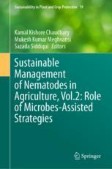Search
Search Results
-
Use of Wild Edible Plants Can Meet the Needs of Future Generation
Despite actual knowledge of measuring ecosystem services, the importance of biodiversity in sustaining such services in diverse landscapes and how...
-
Characterization, pathogenicity, and reproduction of Meloidogyne enterolobii populations parasitizing vegetables in Sinaloa, Mexico
Meloidogyne enterolobii is an emerging species and is considered the most damaging among root-knot nematodes due to its high reproduction and ability...

-
Nutritive Vegetable Crop Germplasm for Future Food Security
Vegetables are the key component of balanced human diet and also the main drivers in achieving global nutritional security by providing nutrient,...
-
Practices and Perceptions of Foragers of Wild Resources in Lagos Metropolis, Nigeria
During the past decades, a growing body of literature has recognized the benefits (including ecological, social, economic, cultural, and...
-
Map-based cloning and functional analysis of a major quantitative trait locus, BolC.Pb9.1, controlling clubroot resistance in a wild Brassica relative (Brassica macrocarpa)
Key messageA causal gene BoUGT76C2 , conferring clubroot resistance in wild Brassica oleracea , was identified and functionally characterized.
...
-
Towards Innovative Strategies for Plant-Parasitic Nematodes Biocontrol in Olive Tree Nurseries
Management of plant parasitic nematodes (PPN) is a major challenge in the agricultural sector. In Morocco, the development of intensive agriculture...
-
Characterization of tomato leaf curl Palampur virus naturally infecting wild melon in Oman
Weeds plants serve as a reservoir of begomoviruses Begomovirus and play a vital role in the diversity of single stranded DNA viruses. Wild melon ( Cucu...

-
Assessing the conservation status, biodiversity potentials and economic contribution of urban tree Ecosystems in Nigerian Cities
We investigated conservation status, biodiversity potentials and economic contribution of urban tree Ecosystems in Nigerian cities. A total of 32...

-
Wild Boar Sus scrofa Linnaeus, 1758
This comprehensive species-specific chapter covers all aspects of the mammalian biology, including paleontology, physiology, genetics, reproduction...
-
The primal garden: Tajikistan as a biodiversity hotspot of food crop wild relatives
Despite being located within a primary region of crop diversity, documentation of Tajik crop and crop wild relative (CWR) resources is far from...

-
The Culture Has Not Faded: Reliance on Diverse Wild Edible Plants in Prehistory, History, and Modern Times
Food embodies our cultural identity, sense of taste, social status, and the extent of dependence on resources. It has been the most crucial element...
-
Powdery mildew (Erysiphe cruciferarum) on Brassicaceae in Brazil
A fungal complex belonging to the order Helotiales (including Erysiphaceae ) has been reported inducing powdery mildew (PM) on members of the...

-
Wild Food and Traditional Knowledge of the Kumiai from Baja California
This work aims to documenting use and importance of natural resources identified as edible by the Kumiai, native people from the northwestern region...
-
Natural Gums for Fruits and Vegetables Preservation: A Review
Recently, natural gum is promising as a novel source for maintaining the postharvest quality, organoleptic properties, and extending the shelf life...
-
Effects of local farm management on wild bees through temporal and spatial spillovers: evidence from Southern India
ContextThe agricultural landscape in many low- and middle-income countries is characterized by smallholder management systems, often dependent on...

-
Land sharing between cultivated and wild plants: urban gardens as hotspots for plant diversity in cities
Plant communities in urban gardens consist of cultivated species, including ornamentals and food crops, and wild growing species. Yet it remains...

-
Identification of Apiaceae using ITS, ITS2 and psba-trnH barcodes
Apiaceae plants are used as medicinal herbs, pesticides, spices, and vegetables; thus, accurately identifying Apiaceae species is important. The...

-
Endophytic actinobacteria from wild medicinal plants are a natural source of insecticide to control the African cotton leafworm (Spodoptera littoralis)
Insecticide resistance in agricultural pests has prompted the need to discover novel compounds with new modes of action. We investigated the potency...

-
Food security and environment conservation through sustainable use of wild and semi-wild edible plants: a case study in Berek Natural Forest, Oromia special zone, Ethiopia
BackgroundWild edible plants (WEPs) have an important role for rural communities in safeguarding food security, nutritive variation and continued...

